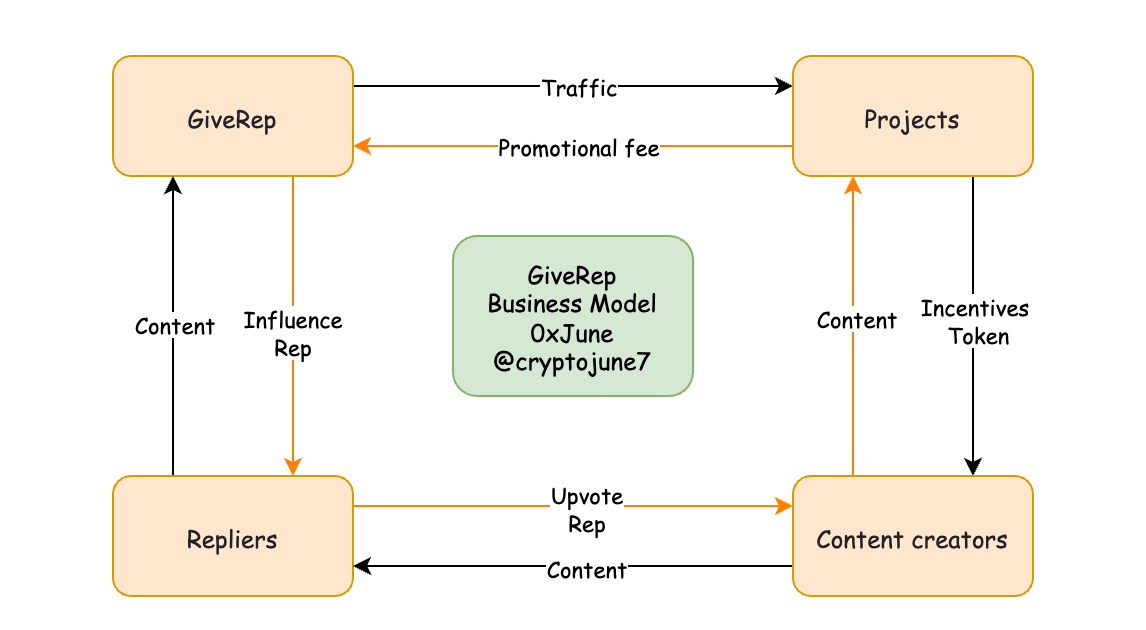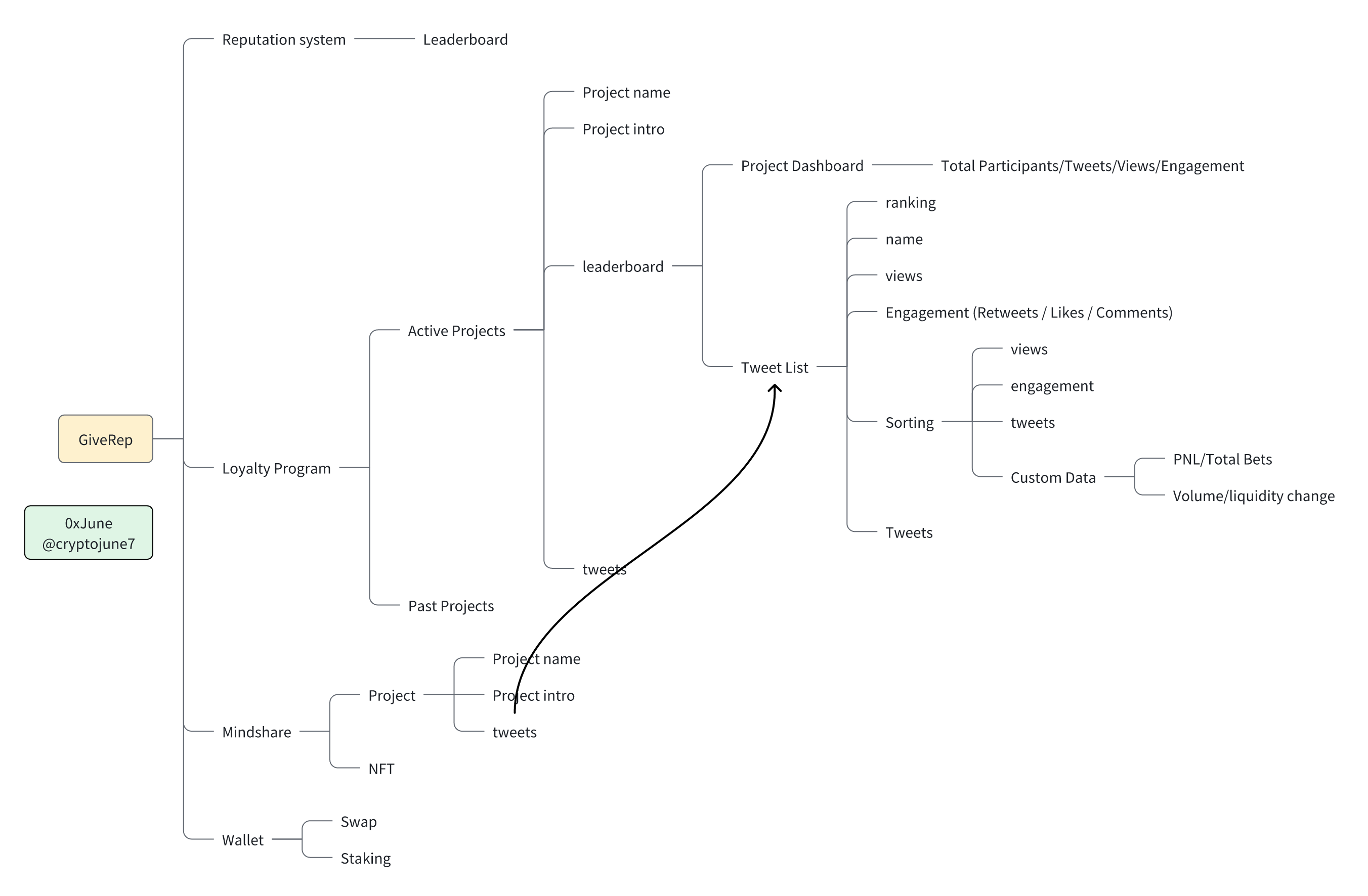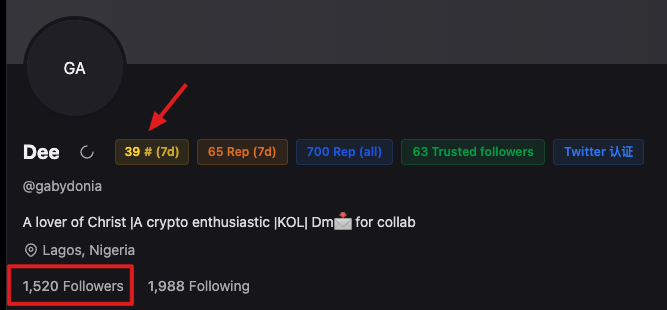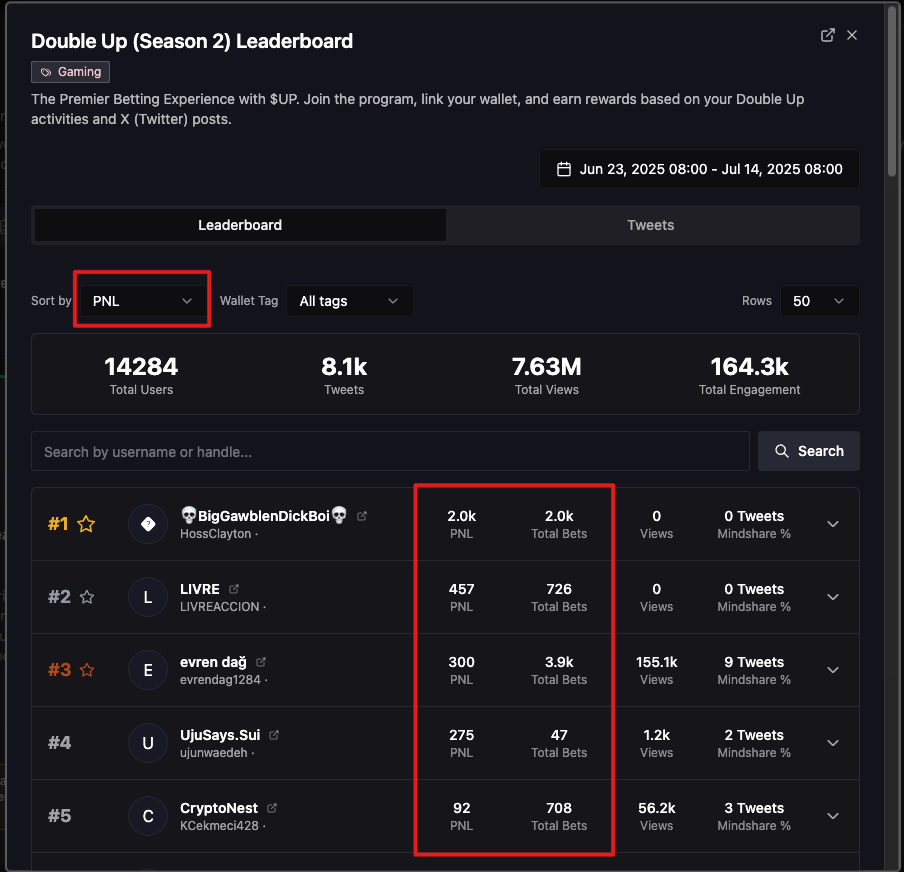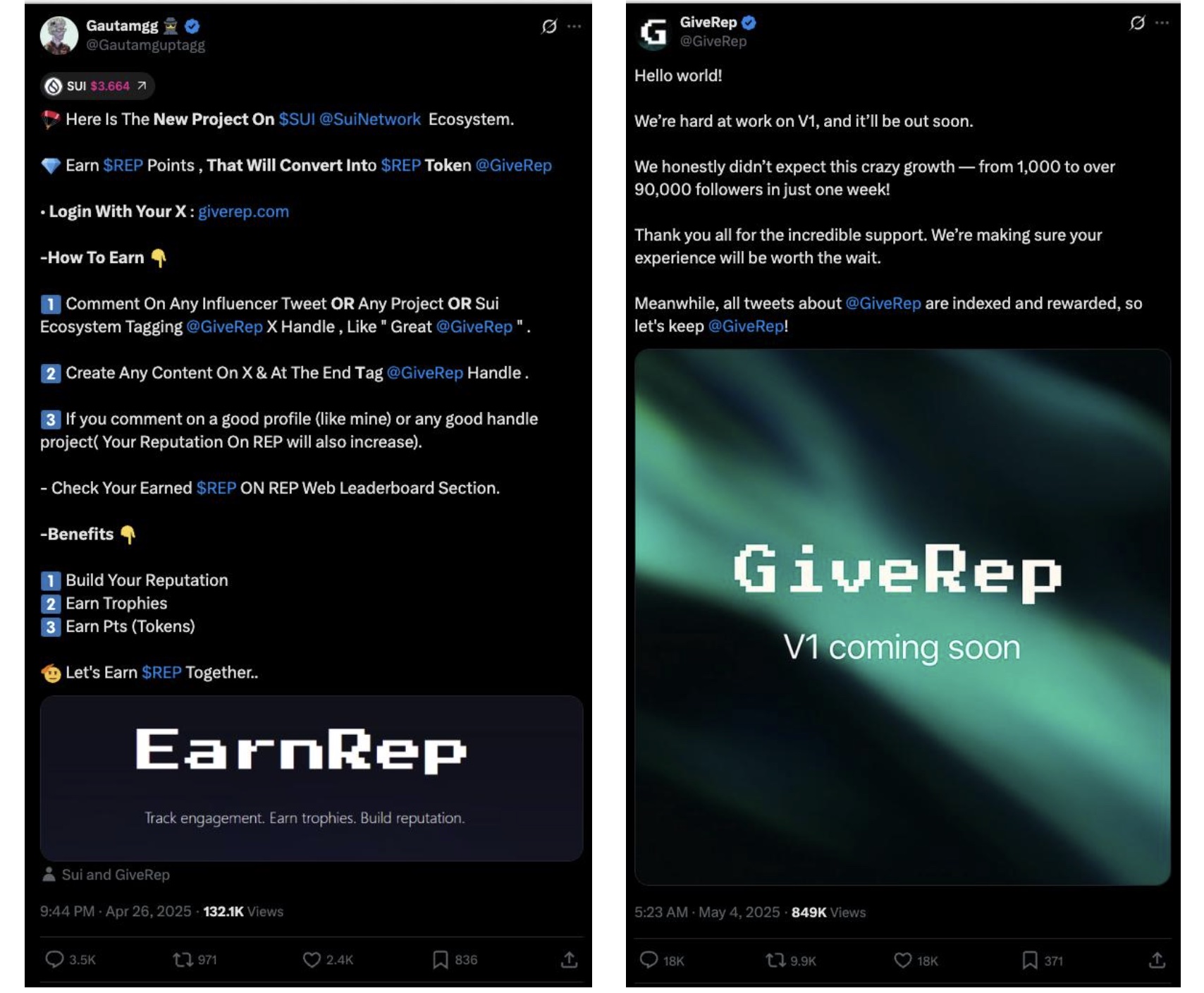How to Reconstruct Social Influence with Web3
GiveRep|Product Analysis (6/100)
1 Product Name
2 Overview
2.1 One-Line Product Overview
GiveRep is a leading InfoFi project within the Sui ecosystem, designed to reward high-quality user-generated content by assigning value to social media output and reputation.
InfoFi, short for “Information Finance,” is built on the idea of turning information streams into financial assets — directly anchoring value to users’ attention, social influence, and content contributions.
2.2 Product Data
Launch Date: April 2025
7-Day Active Users: 40,182 (as of July 2025)
Total Registered Users: 662,991 (as of July 2025)
2.3 Social Media Influence
Followers on X (Twitter): 260K (as of July 2025)
Growth Rate: Gained 250K followers within two months of launch — a testament to viral growth and strong user advocacy.
Engagement Metrics: Average tweet impressions exceed 100K, with top-performing posts reaching 200K+ views.
Flagship Campaigns: Leading Sui ecosystem projects like Cetus, Navi, and Bluefin have launched Loyalty Campaigns on GiveRep.
Individual campaign posts often generate thousands of comments and tens of thousands of engagements, showcasing high community participation and viral traction.
2.4 Team
The GiveRep team has a strong technical foundation, with core developers bringing deep Web3 engineering expertise and prior blockchain experience.
Founder Eason Chen (@Eason_C13) serves as an ambassador for both @SuiNetwork and @WalrusProtocol. He is currently a Ph.D. student at the Human-Computer Interaction Institute (HCII) at Carnegie Mellon University (@cmuhcii), and previously worked as a researcher at @Mysten_Labs. He is also a core contributor to @bucket_protocol.
3 Business Model
- GiveRep
- Acts as the calculator and distributor of reputation points ($REP).
- Automatically scrapes relevant content from Twitter, evaluating and scoring it to assign $REP.
- Delivers reputation-powered, user-incentivized traffic exposure, enabling projects to attract genuine community participation through targeted campaigns.
- Projects
- Submit tasks to GiveRep, which then launches Loyalty Campaigns to activate the community.
- Pay promotional fees to GiveRep in exchange for user traffic and community engagement.
- Use GiveRep’s scoring mechanism and tools to distribute rewards to top-performing creators.
- Leverage the platform to identify authentic, high-quality users and filter out bots or low-engagement participants.
- Content Creators
- Create content — including posts, visuals, and tutorials — based on the tasks in Loyalty Campaigns.
- Earn more $REP through consistent, multi-day engagement.
- Get rewarded by projects through token or USDC incentives for valuable contributions.
- Repliers
- Engage by commenting under tweets and participating in conversations.
- Earn
3 $REPper comment per day, with content creators also receiving $REP when their content attracts replies. - Active repliers can make it onto the leaderboard, gaining visibility and credibility.
Business Model
GiveRep is essentially a decentralized advertising platform. Its core value lies in converting social traffic into measurable reputation through verifiable on-chain engagement data.
- Revenue
- Projects pay GiveRep for campaigns — similar to an ad agency or marketing service.
- Competitive Advantage
- The core of GiveRep is its on-chain reputation system and leaderboard, built around the $REP point system.
- The more users interact, the richer the on-chain data becomes.
- Projects can use historical REP data to identify high-quality creators based on their past content and performance, gradually forming a decentralized creator reputation system.
-
Value Proposition
-
For content creators: A platform to monetize content and build public reputation in a trustable, transparent way.
-
For projects: A highly targeted user acquisition tool that reduces ineffective marketing spend and minimizes airdrop waste. Even a modest budget of $2,000 can spark strong campaign results 🚀
-
For GiveRep: It turns marketing interaction data into long-term on-chain assets, which serve as the foundation for building identity scoring systems, Web3 KOL discovery system, and other data-driven reputation infrastructure.
-
4 Product Architecture
GiveRep is built around four core modules:
1️⃣ Reputation System
2️⃣ Loyalty Program
3️⃣ MindShare
4️⃣ Wallet
5 Core Features
5.1 Reputation System
Key Concepts
- The Reputation Score ($REP) is the primary metric used by GiveRep to evaluate the influence of both KOLs and KOCs.
- $REP is not just a measure of content quality, but a composite indicator of influence — factoring in content virality and interaction intensity.
- All content comes from X (Twitter), but GiveRep will expand to other Web3 media platforms.
Rules
- Users can earn up to 3 REP daily by commenting on others’ tweets and tagging @GiveRep — each qualifying comment earns 1 REP.
- The author of the original tweet also earns passive REP as a “nomination.” The more people comment with @GiveRep, the more REP the author earns.
- Both the commenter and the original author receive REP from the interaction.
- When an influencer tags @GiveRep, the nomination carries 5× REP weight, amplifying their impact.
Leaderboard
- Users can check their REP and rankings on the Leaderboard.
- Dashboard includes verified followers, current REP ranking, total REP, and nominations from verified influencers.
- Rankings filter out bots and ad accounts to ensure quality.
- High rank doesn’t require huge follower counts — 1–2K followers can make Top 50 if interactions are authentic.
Content Quality Control
InfoFi platforms face two major challenges:
- Inflated social metrics — likes, comments, and views can be manipulated.
- Weak content understanding — algorithms fail to distinguish quality analysis from clickbait.
GiveRep’s Solutions:
- Uses engagement/view ratio instead of raw counts to detect real attention and reduce spam.
- Integrates AI-powered semantic analysis to recognize high-quality, in-depth content and minimize low-effort posts.
5.2 Loyalty Program
The Loyalty System is a major growth and monetization engine for GiveRep.
Feature Description
- Users can enroll in project-specific content campaigns directly on the platform.
- Participants publish campaign-related content on X, tagging the project to qualify for rewards such as tokens or potential airdrops. Each campaign includes a dedicated analytics dashboard:
- Participation metrics: total participants, tweets, views, and engagement
- Leaderboards, featured tweet lists, and engagement heatmaps
- Project-specific metrics like: PnL、Total Bets、Volume、Liquidity change
Highlight:
- Transforms “content creation → measurable value” to motivate user participation
- Helps projects gain targeted exposure and access to real, engaged users
- Creators can accumulate project-specific influence through repeated participation
5.3 MindShare (Project Aggregation)
MindShare is a discovery hub showcasing trending Web3 and NFT projects within the Sui ecosystem, based on real-time discussions on X (Twitter).
Features:
- Only vetted projects are listed to maintain quality standards and reduce user filtering costs
- Rankings are automatically generated based on community activity and tweet engagement metrics such as views, likes, and comments.
Highlight:
- Helps users identify hot and trending projects across the Sui ecosystem
- Serves as a content radar for creators looking for relevant topics
- Offers real-time market feedback for projects
- Acts as a community sentiment gauge for investors
MindShare is essentially a “Web3 content signal dashboard”, giving users a window into the ecosystem’s most talked-about projects.
5.4 Wallet
Users must connect a wallet to use GiveRep. The platform links the user’s Twitter handle to their wallet address, enabling a direct connection between on-chain activity and off-chain social identity.
The system builds a visualized Web3 social reputation profile for each user, including:
- Total REP earned
- Influencers who have nominated this user
- Projects the user has participated in and created content for
This allows for the creation of a Verifiable Identity, useful in scenarios like:
- Airdrop eligibility – identifying real, active users
- Project-side discovery – finding high-quality creators and early supporters
- Creator resume building – a Web3 portfolio of influence that represents verified contributions across communities and campaigns
6 Operations Strategy
GiveRep has achieved explosive growth—gaining over 250K followers in just two months, with tweet impressions regularly reaching thousands or even tens of thousands. So, what’s the secret behind this breakout success?
6.1 Early Growth: Backed by the Sui Community + Founder Network Activation
The team has been deeply involved in the Sui ecosystem, participating in ecosystem building, hackathons, and more.
From the very beginning, the project gained exposure through @SuiFamOfficial, including a spotlight in a Suicap video, immediately tapping into Sui’s core user base.
KOLs like @eyezenhour organically promoted GiveRep, praising it as a useful tool to track project engagement on Twitter—this seeded the first wave of authentic word-of-mouth traction.
Viral growth formula: Ecosystem integration + KOL activation + A product that actually delivers value.
6.2 Tipping Point: Loyalty System Launch + KOL Boost
On April 25, GiveRep officially launched its Loyalty System. The first campaign featured Ika (@ikadotxyz), followed shortly by DoubleUp (@doubleup_app). These campaigns offered low participation barriers and clear, direct incentives, quickly driving user engagement.
Prominent community participants, such as @Gautamguptagg, shared detailed posts introducing GiveRep (with over 130K views).
At the end of April, discussions emerged on Twitter around whether “@GiveRep” is case-sensitive, triggering over 100K impressions and creating viral secondary exposure.
On May 4, GiveRep’s official post announced: 90,000 new followers in just 1 week—marking the start of exponential growth.
6.3 Viral Growth: @ Mentions + Leaderboard Network Effects
The @GiveRep nomination mechanism allows users to earn REP daily by commenting on tweets and tagging @GiveRep—this drives organic content circulation.
Each @GiveRep mention = a high-visibility trigger, and since both the commenter and the tweet author earn REP, this creates a two-sided incentive loop.
The Leaderboard keeps users coming back, fueling retention and continued participation.
The entire system is designed to reward content quality and social reputation — not superficial metrics like raw follower counts.
6.4 Summary: Why Is GiveRep Growing So Fast?
-
Native Sui Community Launch:Strong community roots + early exposure from Sui’s official channels gave the project a loud and credible debut.
-
Rapid Iteration & User Feedback:Actively adopting community suggestions, e.g., improving REP mechanics like removing the “100 views = 1 REP” rule, shows responsiveness and adaptability.
-
Gamified Design Mechanisms:Leaderboards, scoring, and fairness incentives drive engagement by creating a sense of competition and progression.
-
KOL-Led Community Growth: KOLs organically promoted GiveRep, which then synergized with the project’s own loyal fan base—creating stronger viral reach than traditional ads.
-
Favorable Market Conditions: The Sui ecosystem was entering a hype cycle, with breakout projects like Walrus and IkaDot driving attention. GiveRep benefited from this strong FOMO environment and user inflow.
7 Product Optimization Recommendations
7.1 GiveRep’s Market Positioning & Differentiated Value
GiveRep belongs to the InfoFi category. While projects like Kaito AI are also part of this track, GiveRep places a greater emphasis on participatory reputation building—a bold attempt to redefine Web3 influence standards.
Looking deeper, GiveRep campaigns track not only traditional metrics like views and engagement, but also extend into project-specific behavioral data. For example:
- DeFi incorporate LP activity;
- Casino may track bets placed.
This enables KOLs to function not only as marketing nodes but also as active users within these ecosystems. In effect, it combines exposure + conversion into a single funnel—a breakthrough in closing the loop on user acquisition.
The most valuable part?
GiveRep integrates conversion, the hardest-to-measure yet most important part of on-chain marketing, into its evaluation framework.
Specifically, project teams can track:
- How many creators generated content for their campaign
- How much interaction (likes, replies, leaderboard rankings) that content received
- How many users connected wallets and actually used the product on-chain
In the current marketing landscape, where ROI remains difficult to quantify, this marks a significant breakthrough in value measurement.
From an industry perspective, GiveRep is contributing to a new influence standard:
- No longer solely based on follower count
- No longer just about views
- Shifting the focus back to content quality, real interactions, and genuine community endorsement.
This shift makes it easier for creators with insightful, high-quality content and real community resonance to get discovered—and monetized—without waiting for projects to reach out.
Just publish valuable content, and rewards will follow.
At the same time, it enables projects to better allocate marketing resources, improving both user acquisition and retention efficiency.
7.2 Current Challenge: REP scoring model remains simplistic
What sets InfoFi apart from traditional content platforms is its core value logic:
instead of relying on centralized recommendation algorithms to determine visibility, InfoFi treats information sharing itself as a value-creating action.
As a flagship InfoFi product, GiveRep’s core mechanism is that commenting is the only way to earn REP.
The platform doesn’t reward original posts directly.
Instead, it evaluates the value of content based on how much it gets discussed:
- Original authors only earn REP passively, triggered by others tagging @GiveRep in comments
- Commenters earn the same amount of REP as the original author—encouraging people to engage with and elevate quality content.
This mechanism was designed with good intentions:
it discourages spam and low-effort content, and encourages users to surface quality contributions—using comments as a decentralized voting signal.
However, the mechanism is not without its flaws:
- Creators post bait questions just to generate replies, even if the question has no real value
- Others exploit FOMO emotions or trending topics to farm interaction, inflating their scores with low-quality content
As a result, “high engagement but low value” posts can dominate the leaderboard, undermining the system’s goal of rewarding meaningful discourse.
Optimization Proposal: Add “Feedback Layer” to Comments
To improve the integrity of the REP system and make scoring more credible, GiveRep could introduce a comment feedback mechanism, allowing users to tag the quality of content being discussed:
Suggested labels:
- 👍 Insightful / Informative
- 🤔 Neutral Discussion
- ⚠️ Low-value / Clickbait / Spam
- 🚫 Misleading / Scam / Harmful Content
Then, use the distribution of feedback types to adjust REP scores:
- Posts with too much negative feedback could result in a REP penalty for the author
- Certain feedback types (e.g. “Scam”) could trigger manual moderation or algorithmic downranking
- High-quality commenters who consistently provide accurate feedback could earn extra REP or be labeled as trusted evaluators
Over time, this could create a decentralized quality control layer, balancing open participation with content integrity.
7.3 The Deeper Question: How Should We Measure “Influence”?
The previous suggestions address fairness and preventing system abuse. But they don’t answer a deeper, more fundamental question:
How should we scientifically define and measure influence?
Most people still equate “reputation” with surface-level engagement—likes, shares, comments. But in reality, this only captures popularity, not true content value.
A more accurate lens is influence—not just how many people saw your content, but:
- Did it change perspectives?
- Did it spark real discussions?
- Did it contribute to community consensus?
While GiveRep has already started incorporating engagement weightings and influencer scores, there are still gaps to address:
- Lack of community interaction indicators: Community response and conversation quality are critical markers of value but aren’t directly reflected in REP scoring yet.
- No vertical-specific scoring differentiation: Influence in different domains (e.g., commentary vs. trading analysis) should not be judged by the same criteria—yet they currently are.
Suggestion:
To improve the accuracy of influence measurement, I recommend optimizing the scoring logic across three core dimensions:
1) Community Engagement
Not just about how many posts someone makes, but:
- Are they engaging in discussions?
- Are they consistently responding, contributing insights, and supporting others?
2) Content Depth
Truly valuable content goes beyond surface-level commentary. It raises critical questions, offers original insights, unpacks complex topics, or introduces new perspectives. Unlike clickbait or emotionally charged posts that aim for virality, high-quality content encourages deeper thinking and drives constructive dialogue.
3) Content Craftsmanship
Even if you have something valuable to say, presentation matters: Well-structured text, eye-catching visuals, data-backed charts, and concise storytelling all help amplify influence
8 Summary
True influence isn’t about how many times your content is viewed — It’s about the reactions it sparks, the awareness it shifts, and the actions it drives within the community.
GiveRep stands out as one of the few blockchain projects that truly understands and captures the essence of content value.
If it can go further—deeper and more precise—in its measurement of influence, it has the potential to break through the current limitations of the InfoFi model. From there, GiveRep could evolve into:
- A Web3 identity infrastructure for content creators, and
- A community-driven, ROI-measurable, decentralized marketing platform that redefines how attention and reputation are monetized in the on-chain world.
觉得文章不错就支持一下呗~

本文版权归 June 所有,采用 CC BY-NC-ND 4.0 国际许可协议 授权。
非商业转载请注明作者及原文链接,禁止改编及用于商业用途,商业合作请联系:yula.qian@gmail.com

